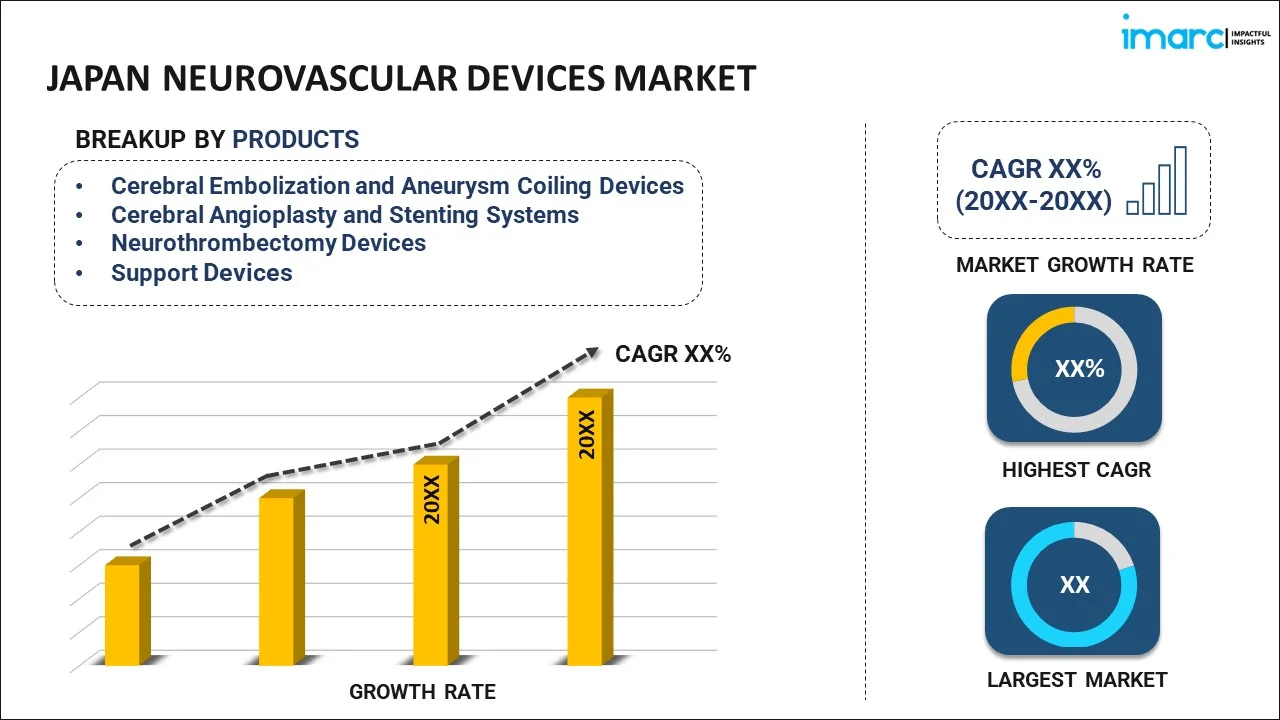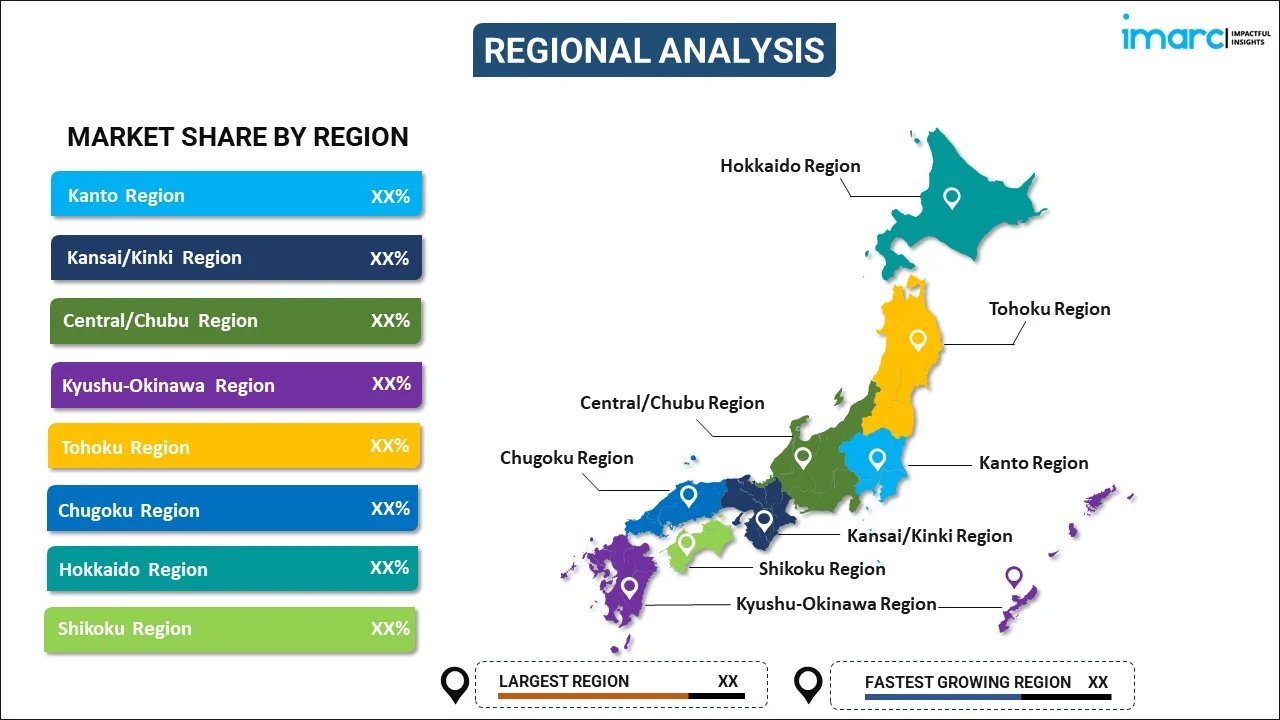
Japan Neurovascular Devices Market Report by Product (Cerebral Embolization and Aneurysm Coiling Devices, Cerebral Angioplasty and Stenting Systems, Neurothrombectomy Devices, Support Devices), Application (Ischemic Stroke, Aneurysm, Arteriovenous Malformation and Fistulas (AVM), Stenosis, and Others), End User (Hospitals, Ambulatory Surgical Centers, Clinics, and Others), and Region 2025-2033
Market Overview:
Japan neurovascular devices market size reached USD 183.8 Million in 2024. Looking forward, IMARC Group expects the market to reach USD 349.4 Million by 2033, exhibiting a growth rate (CAGR) of 7.03% during 2025-2033. Technological progress, a growing incidence of neurovascular conditions, and an aging population that favors less invasive treatments represent some of the key factors driving the market.
|
Report Attribute
|
Key Statistics
|
|---|---|
|
Base Year
|
2024 |
|
Forecast Years
|
2025-2033 |
|
Historical Years
|
2019-2024
|
| Market Size in 2024 | USD 183.8 Million |
| Market Forecast in 2033 | USD 349.4 Million |
| Market Growth Rate (2025-2033) | 7.03% |
Neurovascular devices are medical instruments specifically designed for the diagnosis and treatment of disorders affecting the blood vessels and nervous system within the brain and spinal cord. They are meticulously manufactured using advanced materials and precision engineering methods to ensure their safety and effectiveness. These devices offer substantial benefits by facilitating minimally invasive procedures, thereby reducing patient discomfort, hospitalization durations, and complications. Neurovascular devices have a wide range of applications in addressing various conditions, including aneurysms, arteriovenous malformations, and ischemic strokes. The categories of neurovascular devices encompass stents, embolic coils, flow diverters, and catheters. Stents provide support to maintain blood vessel integrity, while embolic coils assist in blocking blood flow to treat aneurysms. Flow diverters are employed to redirect blood flow away from weakened vessel areas, and catheters enable the targeted delivery of treatments to affected regions.
Japan Neurovascular Devices Market Trends:
The Japan market for neurovascular devices is significantly influenced by the rising incidence of neurovascular disorders, particularly among the elderly population. As life expectancy continues to increase, so does the prevalence of conditions like ischemic strokes and cerebral aneurysms, necessitating advanced medical interventions. Concurrently, technological advancements in neurovascular devices are reshaping the landscape of interventional neurology. Innovations such as flow-diverting stents and detachable coils are augmenting the effectiveness and safety of neurovascular procedures, garnering interest from healthcare providers and patients alike. Furthermore, the growing recognition of the importance of early diagnosis and treatment for neurovascular disorders is driving market expansion. Besides this, public health campaigns and initiatives centered on stroke awareness and the benefits of timely intervention are boosting patient referrals and treatment rates. Additionally, favorable reimbursement policies and the development of healthcare infrastructure in emerging markets are widening access to neurovascular interventions, propelling market growth on a wide scale. Other factors, including extensive research and development (R&D) efforts undertaken by key industry players and an increasing level of awareness among the general populace, are anticipated to propel the regional market in the coming years.
Japan Neurovascular Devices Market Segmentation:
IMARC Group provides an analysis of the key trends in each segment of the market, along with forecasts at the country level for 2025-2033. Our report has categorized the market based on product, application, and end user.
Product Insights:

- Cerebral Embolization and Aneurysm Coiling Devices
- Embolic Coils
- Flow Diverters
- Liquid Embolic Agents
- Cerebral Angioplasty and Stenting Systems
- Carotid Artery Stents
- Embolic Protection Devices
- Neurothrombectomy Devices
- Clot Retrieval Devices
- Suction Devices
- Vascular Snares
- Support Devices
- Micro Catheters
- Micro Guidewires
The report has provided a detailed breakup and analysis of the market based on the product. This includes cerebral embolization and aneurysm coiling devices (embolic coils, flow diverters and liquid embolic agents), cerebral angioplasty and stenting systems (carotid artery stents and embolic protection devices), neurothrombectomy devices (clot retrieval devices, suction devices, and vascular snares), and support devices (micro catheters and micro guidewires).
Application Insights:
- Ischemic Stroke
- Aneurysm
- Arteriovenous Malformation and Fistulas (AVM)
- Stenosis
- Others
A detailed breakup and analysis of the market based on the application have also been provided in the report. This includes ischemic stroke, aneurysm, arteriovenous malformation and fistulas (AVM), stenosis, and others.
End User Insights:
- Hospitals
- Ambulatory Surgical Centers
- Clinics
- Others
The report has provided a detailed breakup and analysis of the market based on the end user. This includes hospitals, ambulatory surgical centers, clinics, and others.
Regional Insights:

- Kanto Region
- Kansai/Kinki Region
- Central/ Chubu Region
- Kyushu-Okinawa Region
- Tohoku Region
- Chugoku Region
- Hokkaido Region
- Shikoku Region
The report has also provided a comprehensive analysis of all the major regional markets, which include Kanto Region, Kansai/Kinki Region, Central/ Chubu Region, Kyushu-Okinawa Region, Tohoku Region, Chugoku Region, Hokkaido Region, and Shikoku Region.
Competitive Landscape:
The market research report has also provided a comprehensive analysis of the competitive landscape. Competitive analysis such as market structure, key player positioning, top winning strategies, competitive dashboard, and company evaluation quadrant has been covered in the report. Also, detailed profiles of all major companies have been provided.
Japan Neurovascular Devices Market Report Coverage:
| Report Features | Details |
|---|---|
| Base Year of the Analysis | 2024 |
| Historical Period | 2019-2024 |
| Forecast Period | 2025-2033 |
| Units | Million USD |
| Scope of the Report | Exploration of Historical and Forecast Trends, Industry Catalysts and Challenges, Segment-Wise Historical and Predictive Market Assessment:
|
| Products Covered |
|
| Applications Covered | Ischemic Stroke, Aneurysm, Arteriovenous Malformation and Fistulas (AVM), Stenosis, Others |
| End Users Covered | Hospitals, Ambulatory Surgical Centers, Clinics, Others |
| Regions Covered | Kanto Region, Kansai/Kinki Region, Central/ Chubu Region, Kyushu-Okinawa Region, Tohoku Region, Chugoku Region, Hokkaido Region, Shikoku Region |
| Customization Scope | 10% Free Customization |
| Post-Sale Analyst Support | 10-12 Weeks |
| Delivery Format | PDF and Excel through Email (We can also provide the editable version of the report in PPT/Word format on special request) |
Key Questions Answered in This Report:
- How has the Japan neurovascular devices market performed so far and how will it perform in the coming years?
- What has been the impact of COVID-19 on the Japan neurovascular devices market?
- What is the breakup of the Japan neurovascular devices market on the basis of product?
- What is the breakup of the Japan neurovascular devices market on the basis of application?
- What is the breakup of the Japan neurovascular devices market on the basis of end user?
- What are the various stages in the value chain of the Japan neurovascular devices market?
- What are the key driving factors and challenges in the Japan neurovascular devices?
- What is the structure of the Japan neurovascular devices market and who are the key players?
- What is the degree of competition in the Japan neurovascular devices market?
Key Benefits for Stakeholders:
- IMARC’s industry report offers a comprehensive quantitative analysis of various market segments, historical and current market trends, market forecasts, and dynamics of the Japan neurovascular devices market from 2019-2033.
- The research report provides the latest information on the market drivers, challenges, and opportunities in the Japan neurovascular devices market.
- Porter's five forces analysis assist stakeholders in assessing the impact of new entrants, competitive rivalry, supplier power, buyer power, and the threat of substitution. It helps stakeholders to analyze the level of competition within the Japan neurovascular devices industry and its attractiveness.
- Competitive landscape allows stakeholders to understand their competitive environment and provides an insight into the current positions of key players in the market.
Need more help?
- Speak to our experienced analysts for insights on the current market scenarios.
- Include additional segments and countries to customize the report as per your requirement.
- Gain an unparalleled competitive advantage in your domain by understanding how to utilize the report and positively impacting your operations and revenue.
- For further assistance, please connect with our analysts.
 Inquire Before Buying
Inquire Before Buying
 Speak to an Analyst
Speak to an Analyst
 Request Brochure
Request Brochure
 Request Customization
Request Customization




.webp)




.webp)












